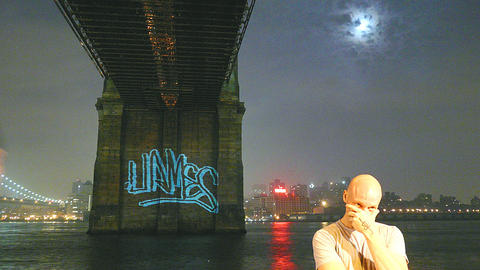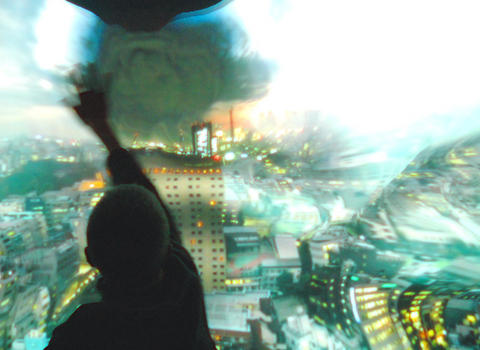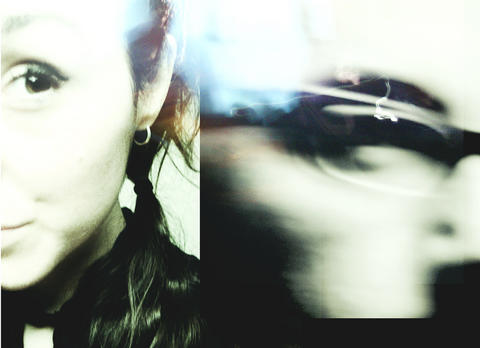G raffiti artists need fear the law no longer - at least that's the word on the street in New York. Two artists versed in "tagging" have come up with a state-of-the-art computer program that enables graffiti writers to replace spray paint with light using a camera, laptop and projector. Combined, artists can project graffiti onto the side of a building. And in the spirit of the creator's open-source ethos, the code for the program, L.A.S.E.R. Tag, is posted online for enthusiasts and artists to "download, dissect, reuse and hopefully improve," according to Graffiti Research Lab's (GRL) Web site (www.graffitiresearchlab.com).
GRL's program is one of the many creations going on display tomorrow as part of Openplay Digital Art Festival in Taipei that runs until Dec. 2 at the Red House Theater (紅樓劇場) in Ximending (西門町).
The participating artists are known as much for their technological prowess as they are for their art. Many of the projects began as research and were then developed into art or, in some cases, for commercial use. And although it required considerable technical skill to create the works - some of the artists have PhDs in computer science or engineering - the creations are relatively simple to understand and manipulate.

PHOTO: COURTESY OF THE DIGITAL ART FESTIVAL
For Valentina Vuksic's installation, Harddisko, the artist gathered 16 defective PC hard disks, removed the casings and connected them to a sound mixer using simple electric circuits. As soon as the power is turned on, the disks move in specific patterns and generate sound. The result can be compared to an orchestra of various instruments.
Like Harddisko, Interactive Sonic Systems' ReacTable is a digital musical instrument. It consists of a round table set with illuminated plastic picture tiles. Each one generates a specific sound or modifies sound in some way. Visitors play it by arranging and rearranging the tiles, producing a variety of sounds. The ReacTable also provides visual feedback on the table.
Instead of playing with sound, Alvaro Cassinelli's The Khronos Projector allows viewers to explore prerecorded movie content in new ways. Rather than viewing a movie chronologically, the user is able to send parts of the image forward or backward in time by touching the projection screen. For example, the image of a daytime cityscape becomes, at the point where the hand or finger moves along the surface of the screen, dusk and eventually evening. As soon as the viewer's hand is lifted, the screen returns to the daytime scene.

PHOTO: COURTESY OF THE DIGITAL ART FESTIVAL
The Robotic Chair by Canadian artists Raffaello d'Andrea, Max Dean and Matt Donovan, falls apart and puts itself back together. Watching the wooden, classroom chair spontaneously fall apart and gradually reassemble itself is a surreal experience, and seems to be a statement about the ability of humans to do the same.
Contemporary art, it would seem, has split into two parts: that which is looked at and contemplated and that which is played with and manipulated. The works at the second Digital Art Festival fall into the latter category and visitors should be fascinated, regardless of what their definition of art is.

PHOTO: COURTESY OF THE DIGITAL ART FESTIVAL

May 11 to May 18 The original Taichung Railway Station was long thought to have been completely razed. Opening on May 15, 1905, the one-story wooden structure soon outgrew its purpose and was replaced in 1917 by a grandiose, Western-style station. During construction on the third-generation station in 2017, workers discovered the service pit for the original station’s locomotive depot. A year later, a small wooden building on site was determined by historians to be the first stationmaster’s office, built around 1908. With these findings, the Taichung Railway Station Cultural Park now boasts that it has

Wooden houses wedged between concrete, crumbling brick facades with roofs gaping to the sky, and tiled art deco buildings down narrow alleyways: Taichung Central District’s (中區) aging architecture reveals both the allure and reality of the old downtown. From Indigenous settlement to capital under Qing Dynasty rule through to Japanese colonization, Taichung’s Central District holds a long and layered history. The bygone beauty of its streets once earned it the nickname “Little Kyoto.” Since the late eighties, however, the shifting of economic and government centers westward signaled a gradual decline in the area’s evolving fortunes. With the regeneration of the once

The latest Formosa poll released at the end of last month shows confidence in President William Lai (賴清德) plunged 8.1 percent, while satisfaction with the Lai administration fared worse with a drop of 8.5 percent. Those lacking confidence in Lai jumped by 6 percent and dissatisfaction in his administration spiked up 6.7 percent. Confidence in Lai is still strong at 48.6 percent, compared to 43 percent lacking confidence — but this is his worst result overall since he took office. For the first time, dissatisfaction with his administration surpassed satisfaction, 47.3 to 47.1 percent. Though statistically a tie, for most

In February of this year the Taipei Times reported on the visit of Lienchiang County Commissioner Wang Chung-ming (王忠銘) of the Chinese Nationalist Party (KMT) and a delegation to a lantern festival in Fuzhou’s Mawei District in Fujian Province. “Today, Mawei and Matsu jointly marked the lantern festival,” Wang was quoted as saying, adding that both sides “being of one people,” is a cause for joy. Wang was passing around a common claim of officials of the People’s Republic of China (PRC) and the PRC’s allies and supporters in Taiwan — KMT and the Taiwan People’s Party — and elsewhere: Taiwan and